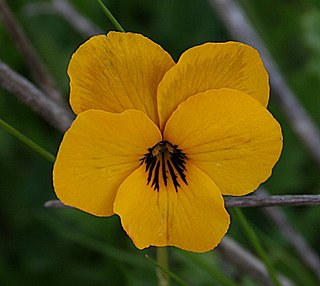
Viola pedunculata, the California golden violet, Johnny jump up, or yellow pansy, is a perennial yellow wildflower of the coast and coastal ranges in California and northwestern Baja California. The common name "Johnny jump up" is usually associated with Viola tricolor however, the introduced garden annual.

Viola odorata is a species of flowering plant in the genus Viola, native to Europe and Asia. This small hardy herbaceous perennial is commonly known as wood violet, sweet violet, English violet, common violet, florist's violet, or garden violet. It has been introduced into North America and Australia.

Viola canadensis is a flowering plant in the Violaceae family. It is commonly known as Canadian white violet, Canada violet, tall white violet, or white violet. It is widespread across much of Canada and the United States, from Alaska to Newfoundland, south as far as Georgia and Arizona. It is a perennial herb and the Latin specific epithet canadensis means of Canada.

Viola sororia, known commonly as the common blue violet, is a short-stemmed herbaceous perennial plant that is native to eastern North America. It is known by a number of common names, including common meadow violet, purple violet, woolly blue violet, hooded violet, and wood violet. Its cultivar 'Albiflora' has gained the Royal Horticultural Society's Award of Garden Merit. This perennial plant species is distributed in the eastern half of the United States, Canada and a part of Eastern Mexico. Their native habitats are rich, moist woods, and swamps located in the eastern half of the United States and Canada.

Viola adunca is a species of violet known by the common names hookedspur violet, early blue violet, sand violet, and western dog violet. It is native to meadows and forests of western North America, Canada, and the northern contiguous United States.
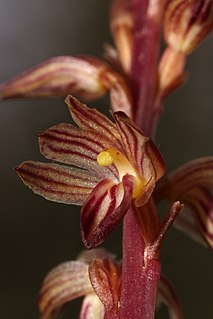
Corallorhiza striata is a species of orchid known by the common names striped coralroot and hooded coralroot. This flowering plant is widespread across much of southern Canada, the northern and western United States, and Mexico. It lives in dry, decaying plant matter on the ground in pine and mixed coniferous forests, and it obtains its nutrients from fungi via mycoheterotrophy.
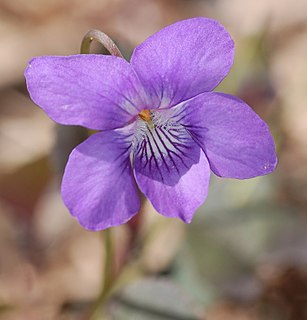
Viola labradorica, commonly known as alpine violet, American dog violet, dog violet or Labrador violet, is a perennial herbaceous flowering plant. It is native to Greenland, eastern Canada, and the eastern United States. The plant sold as Viola labradorica by nurseries is Viola riviniana.

Utricularia striata, the striped bladderwort, is a medium-sized affixed subaquatic carnivorous plant that belongs to the genus Utricularia. U. striata is endemic to the eastern coastal plains of the United States.

Fritillaria striata, the striped adobe lily, is an uncommon species of fritillary.
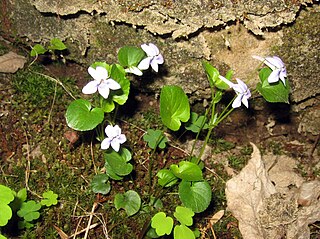
Viola rostrata, commonly called the long-spurred violet, is an herbaceous plant in the violet family (Violaceae). It is native to eastern North America, where it is found in Canada and the United States, primarily in the Northeastern, Midwestern, and Appalachian regions. Its natural habitat is acidic mesic forests, often growing near Tsuga canadensis.
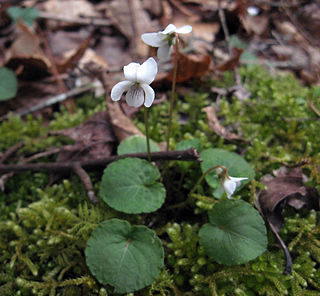
Viola blanda, commonly called the sweet white violet, is a flowering perennial plant in the Violet family (Violaceae). It is native to parts of south-eastern and south-central Canada and the eastern, and north-central, United States. Its natural habitat is in cool, mesic forests.

Viola nephrophylla syn. Viola nephrophylla Greene f. albinea (Farw.), Viola pratincola Greene, Viola retusa Greene ) is an annual or perennial forb in the Violet family (Violaceae) native to North America.

Viola pedatifida, known variously as prairie violet, crow-foot violet, larkspur violet, purple prairie violet, and coastal violet, is a perennial herbaceous plant in the Violet family (Violaceae). It is native to Canada and the United States.
Stuckenia striata is a species of aquatic plant known by the common names broadleaf pondweedNevada pondweed and striped pondweed. It is native to the Americas, including the southwestern United States, northern Mexico, and parts of Central and South America. It grows in waterways such as rivers, canals, and shallow ponds, often in alkaline water. This is a perennial herb producing a long, thin, branching stem approaching 2 m in maximum length. The narrow, hairlike leaves are up to 10 cm (3.9 in) long and only a few millimeters wide. The inflorescence is a spike of flowers arranged in whorls and borne on a short peduncle.

Kummerowia striata is a species of flowering plant in the legume family known by the common names Japanese clover and common lespedeza. It is native to much of Asia and it is present in the eastern United States as an introduced species.
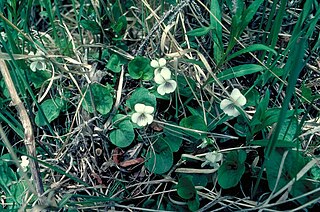
Viola renifolia is a species of violet known by the common names white violet and kidneyleaf violet. It is native to northern North America, where it has a widespread distribution across Canada and the northern United States as far south as Washington, Colorado, and New York.
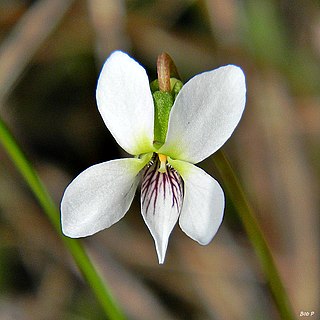
Viola lanceolata, commonly known as lance-leaved violet or bog white violet, is a small group of stemless white-flowered violets. It is an ornamental plant in the Violaceae family, part of the genus Viola. It gets its name from its lanceolate leaf shape and from the habitats in which it thrives.

Viola selkirkii is a species of violet known by the common names Selkirk's violet and great-spur violet. It is native throughout the Northern Hemisphere, its distribution circumboreal.

Viola sagittata, commonly called the arrowleaf violet, is a species of flowering plant in the violet family (Violaceae). It is native to the eastern North America in Canada and the United States, where it is widespread. It is found in a variety of natural habitats, but is most common in dry, open communities such as prairies, glades, or woodlands, often in sandy or rocky soil.


















